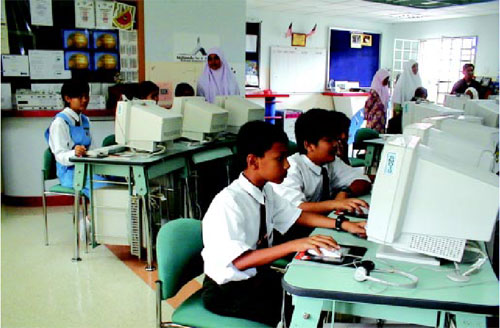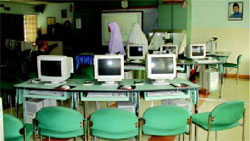
The Smart Schools in Malaysia were never intended for smart students only when they were firstenvisioned. It was an ambitious project that brought together the Education Ministry, private industries andother stakeholders to work hand-in-hand to create a schooling culture that is informed, thinking, andcreative using technology as an enabler in the teaching and learning process in line with the country’sneeds to make the critical transformation from a production-based economy to a knowledge-basedeconomy by 2020. The project started with 87 pilot schools from 1999 is now being expanded to reach10,000 schools by the year 2010. The featured story focuses on the implementation of the teaching andlearning processes at the pilot schools and the challenges faced by the schools in trying to achieve thestipulated goals of the Smart Schools. It also looks at the post pilot phase and the rollout plans lay down bythe Ministry to move forward towards achieving Malaysia’s vision of producing knowledge-based workers.
At the initial stage of the smart school project, many people had the notion that the Smart School was a school for smart students only, and that without the presence of technology or computers, a school could not be termed a Smart School. Therefore, to put it in the right perspective, it must be stressed here that the Smart School is for all children and technology is just an enabler and not a driver, and its presence in the schools does not mean it can catalyse better educational outcomes. It is however correct to say that with the use of technology, we are able to take the Smart School to its destination more quickly and efficiently.

The Conceptual Blueprint that was published in 1997 defines the Smart School as “a learning institution that has been systemically reinvented in terms of teaching-learning practices and school management in order to prepare children for the Information Age”. The word “systemically reinvented” is used in the definition because the Ministry of Education, Malaysia intends to make a radical transformation to the education system by reviewing the curriculum and pedagogy, enhancing the roles of teachers, administrators, parents and the community, and empowering the students to become more responsible for their own learning by practising self-accessed, self-directed and self-paced learning.
The presence of the information and communication technology (ICT) is critical because it helps in making the teaching and learning processes more interesting and enriching, and in the long run, the students will become more technology savvy. The Smart School initiative has been planned to ensure that the education system prepares future Malaysian citizens not only as knowledge workers for the Information Age but to be able to achieve Malaysia’s vision of becoming a fully developed nation by the year 2020.
The Pilot Phase
The Smart School project started in early 1996 when the Ministry of Education (MOE), Malaysia first discussed its concept and implications on the education system. By late 1996, the Smart School Flagship became one of the seven applications identified under the Multimedia Super Corridor (MSC) initiative (The MSC is a 15 x 50 km zone, stretching from the Kuala Lumpur City Centre to the Kuala Lumpur International Airport launched in 1996 as a regional launch site for companies developing or using leading multimedia technology).
The Telekom Smart School (TSS), a consortium led by Telekom Malaysia was awarded the contract to develop the applications. The Multimedia Development Corporation (MDeC), a private company wholly owned by the Malaysian Government to manage and market the MSC, also collaborated with the Ministry of Education to ensure the implementation of the Smart School flagship.
Ninety schools throughout Malaysia were identified to pilot the project but this was later reduced to 87 because three new Smart Schools could not be built on time when the pilot was launched. This included 83 secondary and 4 primary schools. Of these, 6 new schools (2 secondary and 4 primary) were built and provided with the level A (Full Classroom Model) Smart School technology specification and the rest were existing secondary schools (41 fully residential schools and 40 day schools) that were provided with level B (Laboratory Model) and one school with level B+ (Limited Classroom Model) technology specifications. Each new Smart School with the A technology level was provided with 520 computers (7 computers in all the classrooms and science labs, 4 computer labs with 36 computers each, and the rest in the teachers’ room, resource centre, and the administrative office); Level B schools were provided with 37 computers (one computer lab with 21 computers, and the others in the resource centre and administrative office); and the Level B+ school was provided with 81 computers (6 computers in 15 classrooms and science lab and the rest in the resource centre and administrative office).
-
Technology Infrastructurecomprising IT and non-ITequipment, Local Area Networks,and a virtual private network thatconnects the pilot schools, theMinistry’s Data Centre and HelpDesk;
-
Support Services in the form of acentralised Help Desk, andservice centres throughout thecountry to provide maintenanceand support;
-
Funding for the Smart SchoolProject was provided by thegovernment with an allocation ofRM400 million, of which RM100million was for the training ofadministrators and teachers onthe Smart School concept andRM300 million was for theimplementation of the SmartSchool Integrated Solution(SSIS) in the 87 pilot schoolsunder the Pilot Project Agreementbetween the Government andTSS signed in 1999.
The Smart School Curriculum was developed by the Curriculum Development Centre; pre-service and in-service training of teachers was conducted by the Teacher Education Division; and the training of school administrators was undertaken by the Aminuddin Baki Institute, the Ministry of Education’s staff development centre.
The Smart School Pilot Project ended in December 2002, with 87 networked schools throughout the country, 1494 courseware titles for the 4 subjects, a computerised and integrated Smart School Management System, a Help Desk and Data Centre, and trained administrators, teachers, and IT coordinators in all the pilot schools.
The Smart School concept
The teaching and learning environment is integral to the Smart School concept and comprises four areas, namely, the curriculum that is designed to help students achieve overall and balanced development; pedagogy that allows for the appropriate mix of learning strategies to ensure mastery of basic competencies and promotion of holistic development; assessment that is designed to give accurate feedback of students’ readiness, progress, achievement and aptitude; and teaching and learning materials that are cognitively challenging and motivating by combining the best of network-based, teacher-based, and courseware materials.
Initial evaluation of the Smart School Pilot Project
With the implementation of the Smart School project, the Schools Division was requested to coordinate the evaluation process, and the collaborative onitoring was carried out twice, once in 2000 and another one in 2001, after which it was taken over by the Smart School Team at the Technology Education Division. When the monitoring was conducted in 2000 and 2001, the Smart School Integrated Solution was not fully released to the schools and the full integrated solution was only utilised fully in March 2003.
Evaluation of the Pilot Schools in the post-pilot phase (2002 – 005)When the pilot project was successfully concluded in 2002, evaluation studies were carried out by various groups commissioned by the Ministry of ducation and MDeC. These included a benchmarking study by Frost and Sullivan, an independent consultant, to compare the Malaysian Smart School’s Integrated Solution with eight other countries, a study by local academics, and echnology evaluation by the Smart School team and TSS. The benchmarking study compared the merits of the SSIS and its components with similar implementations in Australia, Britain, Canada, Ireland, Japan, New Zealand, ingapore and the USA to benchmark their best practices in ICT-mediated education with that of Malaysia. The study reported that no other country had contemplated automating the whole school process and the Malaysian achievement had brought such sophisticated advantages within the reach of the average child attending a government school. The Teaching and Learning (TLM) courseware was also tailor-made for the Malaysian curriculum whilst schools in the other countries used courseware developed for the generic arket. One of the recommendations made by the study was to intensify change management programmes and pedagogy training for all teachers on how to integrate ICT in teaching and learning. The study by the local academics found that almost half of the teachers surveyed mentioned that in-house training for subject teachers was only moderately successful in achieving its objectives and the trainings were not repeated for new teachers who had just been transferred to the school and had never attended any Smart School training. The Senior Assistants also said that the teachers needed more effective training than what was available and delivered in-house. The technology evaluation by the Smart School team and TSS found that the Smart School Courseware was under-utilised as teachers preferred to use the newer courseware produced to teach Science and Mathematics in English while the Smart School courseware was in the Malay Language. This was because the government changed the policy for the teaching of these two subjects in English starting in 2003 for Primary Year 1, and Secondary Forms 1 and Lower Six students. Findings from the evaluations helped the Smart School team to identify measures to try to overcome the issues with regards to technology, infrastructure, support, and human resources.
Making All Schools Smart
In the original Implementation Plan, the Ministry of Education intended to use the findings of the Pilot Project to prepare a Master Plan to ensure that all schools in the country become Smart Schools in stages, by the year 2010. The Government of Malaysia would play the role of architect and driver by preparing guidelines and providing basic amenities to schools, and actively encouraging all schools to become Smart Schools on their own initiative by using their own financial resources and expertise. Following the Pilot Project from 1999 to 2002 and the post-pilot phase from 2002 to 2005, the Ministry of Education developed a visionary plan for the roll out of the Smart School from 2006 to 2010. The plan to make all the schools “smart” by 2010 would leverage on all the ICT Initiatives the Ministry of Education had undertaken such as the Computer Lab project (to provide computer labs to all schools), Teaching of Mathematics and Science in English (PPSMI), Training of teachers to teach Mathematics and Science in English (ETeMS), SchoolNet Project (to provide internet broadband facilities), and Educational TV (ETV). Much of the activities between 2006 until 2010 will be focused on ensuring that all schools are equipped with the hardware and courseware (and all new courseware developed will be webenabled), and rigorous training of teachers and administrators for the implementation of the Smart School, and change management programmes conducted to instill the ownership of the Smart School initiative among the stakeholders. The Malaysian government has made an ambitious and bold initiative and has laid the foundation for our schoolchildren, the future citizens, to progress towards achieving Vision 2020. It is now up the various stakeholders to play their part and ensure that the path towards achieving the goals is obstacle-free.






















